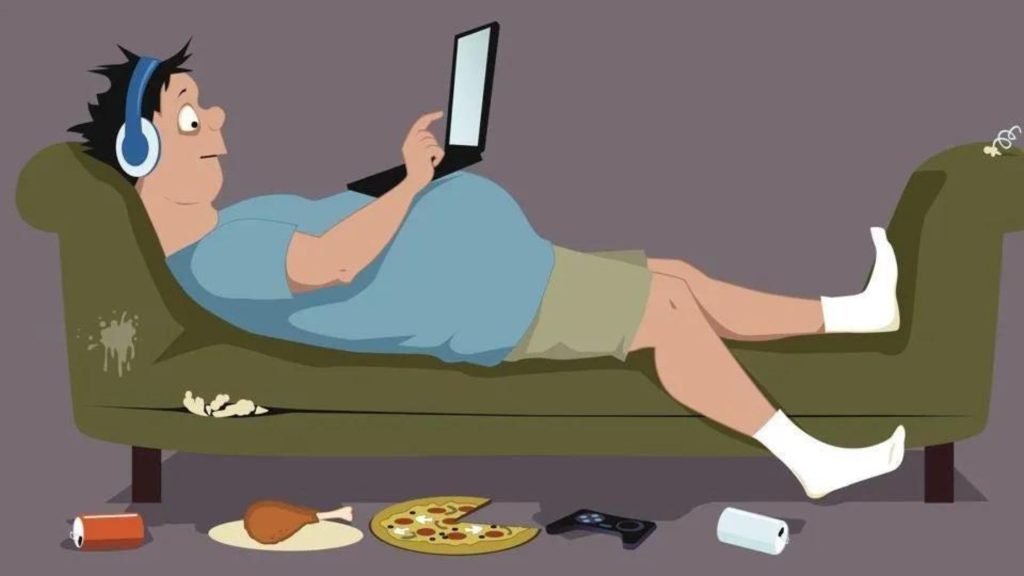Introduction:
Living a sedentary lifestyle means engaging in little to no physical activity and spending a significant amount of time sitting or lying down. In today’s fast-paced world, sedentary behavior has become increasingly common, leading to various health concerns. This article aims to define sedentary lifestyle in simple terms, explore its consequences, and provide practical tips to lead a more active life.

The Sedentary Lifestyle Defined:
A sedentary lifestyle refers to a pattern of behavior characterized by minimal physical activity and prolonged periods of sitting or reclining. It involves activities such as watching TV, using the computer, driving for long hours, or sitting at a desk job without much movement.
What Makes a Lifestyle Sedentary?
A sedentary lifestyle is typically characterized by low levels of energy expenditure. Instead of engaging in activities that require movement, individuals spend a significant portion of their day in a seated or lying position.
The Role of Technology:
Technological advancements have contributed to the rise of sedentary lifestyles. With the widespread availability of smartphones, computers, and entertainment devices, people are spending more time engaging in screen-based activities and less time being physically active.
The Impact of Sedentary Behavior:
Leading a sedentary lifestyle can have far-reaching consequences for both physical and mental health. Let’s explore some of the key effects:
Physical Health Effects:
- Obesity: Lack of physical activity contributes to weight gain and obesity. When energy intake exceeds energy expenditure, excess calories are stored as fat, leading to weight gain over time.
- Cardiovascular Disease: Prolonged sitting is associated with an increased risk of heart disease, stroke, and other cardiovascular conditions. It can lead to elevated blood pressure, high cholesterol levels, and impaired circulation.
- Musculoskeletal Issues: Sitting for long periods can cause muscle stiffness, joint pain, and poor posture. It may also contribute to the development of chronic conditions such as back pain and osteoarthritis.

Mental Health Effects:
- Depression and Anxiety: Sedentary behavior has been linked to an increased risk of depression and anxiety. Lack of physical activity can affect mood-regulating hormones and neurotransmitters, leading to feelings of sadness and stress.
- Decreased Cognitive Function: Prolonged sitting may impair cognitive function and increase the risk of cognitive decline in later life. Regular physical activity has been shown to improve memory, attention, and overall cognitive performance.
Combating Sedentary Behavior:
Fortunately, there are simple steps you can take to reduce sedentary behavior and improve your overall health and well-being:
Stay Active Throughout the Day:
Incorporate movement into your daily routine by taking short breaks to stretch or walk around. Set reminders to stand up and move every hour, especially if you have a desk job.
Engage in Regular Exercise:
Make physical activity a priority by scheduling regular exercise sessions. Aim for at least 150 minutes of moderate-intensity aerobic activity or 75 minutes of vigorous activity per week, along with muscle-strengthening exercises.
Find Activities You Enjoy:
Choose activities that you enjoy and that fit your lifestyle. Whether it’s walking, swimming, dancing, or gardening, find activities that you find enjoyable and can sustain in the long term.

FAQs (Frequently Asked Questions):
Is sitting all day bad for you?
Yes, sitting for extended periods can have negative effects on your health. It increases the risk of obesity, heart disease, and other chronic conditions. It’s important to break up long periods of sitting with short movement breaks.
How can I reduce sedentary behavior at work?
To reduce sedentary behavior at work, try standing or walking during phone calls, taking short walking breaks, and using a standing desk if possible. Set reminders to stand up and stretch every hour.
Can watching TV contribute to a sedentary lifestyle?
Yes, excessive TV watching is a sedentary activity that can contribute to a sedentary lifestyle. Limit screen time and try to engage in more active forms of entertainment.
Can sedentary behavior be reversed?
Yes, sedentary behavior can be reversed with lifestyle changes. Incorporating more physical activity into your daily routine and reducing the amount of time spent sitting can help improve your health.
Conclusion:
In conclusion, understanding the definition of a sedentary lifestyle and its consequences is essential for maintaining good health. By making small changes to incorporate more movement into our daily lives, we can reduce the negative effects of sedentary behavior and improve our overall well-being.

